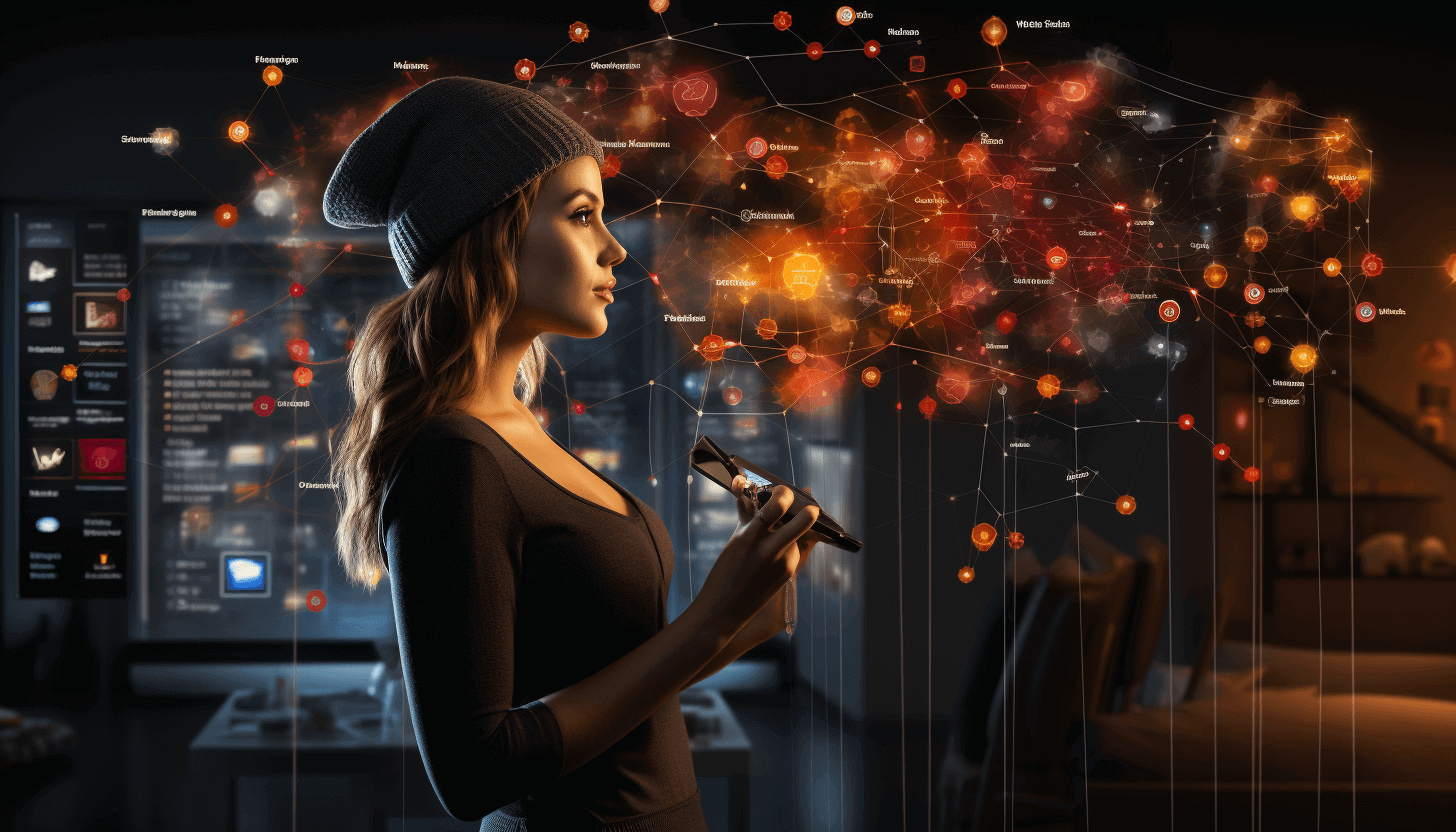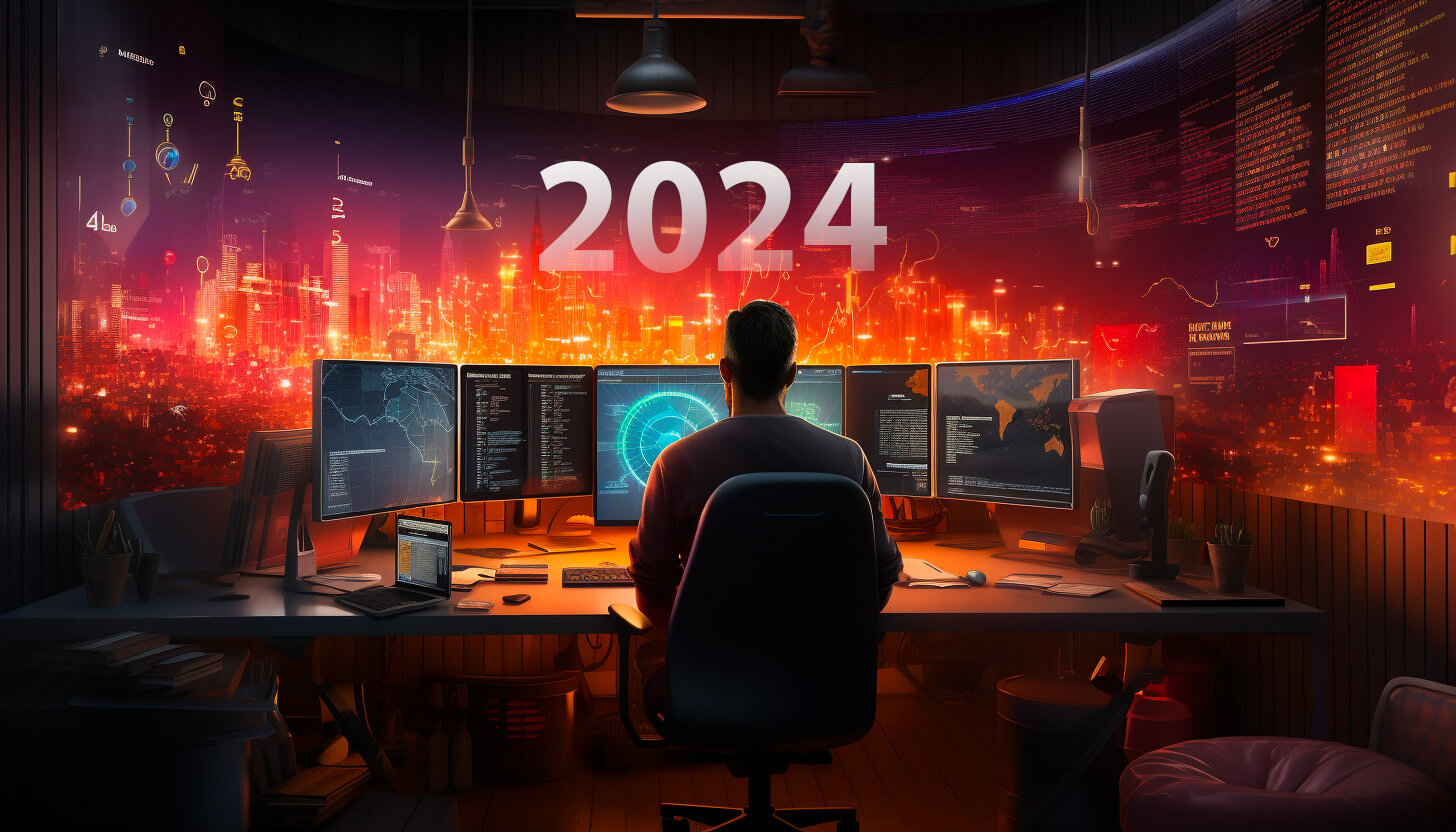Emerging UX Trends in 2024: Navigating the Future of B2B Digital Experience
As we advance into 2024, the realm of Business-to-Business (B2B) User Experience (UX) design is undergoing a remarkable transformation. In an era where digital interactions are increasingly pivotal, B2B platforms are not just focusing on functionality and aesthetics; they are redefining how they engage with users. The latest trends in B2B UX design reflect a deeper understanding of user needs, an embracement of cutting-edge technologies, and a commitment to creating more efficient, engaging, and intuitive experiences.
The landscape of 2024 is marked by innovative approaches like AI-driven personalization, advanced data visualization, and the integration of voice and NLP interfaces, reshaping the way professionals interact with B2B platforms. Moreover, the focus has shifted towards not just meeting user expectations but anticipating them, leading to more predictive and proactive user interfaces.
This blog post delves into the most significant B2B UX design trends of 2024, each representing a leap forward in how businesses connect, communicate, and cater to their professional clientele. From the emergence of hyper-personalization to the integration of ethical and sustainable practices, these trends are setting new standards for the B2B digital experience. Whether you are a UX designer, a business leader, or a tech enthusiast, understanding these trends is key to navigating the ever-evolving world of B2B technology.
Join us as we explore these transformative trends, shedding light on how they are shaping the present and future of B2B UX design, and what they mean for businesses striving to stay at the forefront of innovation.

AI-Driven User Experience Personalization
In 2024, the B2B sector is experiencing a significant evolution in user experience (UX) design, driven predominantly by advancements in Artificial Intelligence (AI). This trend is particularly noticeable in B2B enterprise tools, where AI's role in personalizing user experience is not just a feature, but a fundamental shift in approach. Let's delve into how AI-driven personalization is revolutionizing UX in the B2B landscape.
Hyper-Personalization: A New Standard in B2B UX
Gone are the days when personalization in B2B tools was limited to user role-based interfaces. Now, with AI, hyper-personalization has become the new norm. AI algorithms can process and analyze extensive user data, including engagement patterns, workflow preferences, and task frequencies. This deep analysis enables the creation of a UX that is not just user-friendly but anticipates the user's needs, leading to a more efficient and effective work process.
Real-World Applications of AI in B2B Tools
Imagine a project management tool that uses AI to understand each team member's work habits, automatically adjusting task assignments and deadlines to optimize team productivity. Or consider an enterprise resource planning (ERP) system that predicts resource allocation needs based on historical data, helping businesses to plan more effectively and avoid potential bottlenecks.
Enhancing User Connections with AI
The impact of AI-driven UX in B2B tools extends beyond mere convenience. It's about creating an intuitive understanding of each business's unique operational needs and delivering a user experience that feels tailor-made. This level of personalization not only improves efficiency but also builds a deeper trust in the tool, as users feel their specific business requirements are understood and addressed.
Embracing the AI-Driven UX Evolution
As we continue through 2024, AI-driven UX is not just a trend to watch; it's becoming a crucial aspect of B2B tool design. Businesses embracing this evolution find themselves better equipped to face the challenges of an increasingly digital world. AI-driven UX is not just enhancing the user experience; it's reshaping how B2B enterprises interact with their tools, leading to more insightful, adaptive, and intelligent workflows.

Advanced Data Visualization Techniques
As we progress through 2024, B2B UX design is witnessing a significant transformation in how data is visualized and interacted with. Advanced data visualization techniques are not just about presenting information; they're about creating a more intuitive and insightful experience for decision-makers. Let's dive into the new trends and functionalities defining data visualization in B2B platforms this year.
Interactive and Real-Time Data Visualization
One of the most prominent trends in 2024 is the shift towards interactive and real-time data visualizations. B2B platforms are now equipped with dashboards that not only display data but also allow users to interact with it dynamically. Users can drill down into metrics, adjust parameters, and see changes in real-time, offering a deeper understanding and immediate insights into complex data sets. This interactivity transforms static charts and graphs into tools for exploration and discovery.
Predictive Analytics and Forecasting Visuals
Another leap forward is the integration of predictive analytics into data visualization tools. B2B platforms are harnessing machine learning algorithms to forecast trends and outcomes, which are then visually represented in the UX. These predictive visuals help businesses anticipate market changes, customer behavior, and potential risks, facilitating proactive decision-making. The ability to see predictive analytics in an easily digestible format is a game-changer for strategic planning in the B2B sector.
Personalized Data Storytelling
2024 also sees a rise in personalized data storytelling. Data visualization tools are now able to tailor the presentation of data to the specific role and interests of the user. For instance, a marketing manager and a financial officer may see different visual representations of the same data set, each optimized for their specific use cases and decision-making processes. This personalized approach ensures that users are not overwhelmed with irrelevant data, enhancing efficiency and focus.
Augmented Reality (AR) in Data Visualization
An exciting development in B2B UX design is the use of Augmented Reality (AR) for data visualization. AR technology is being used to project data into the physical workspace, allowing users to interact with 3D data models in real-time. This method of visualization provides a more immersive and engaging way to understand complex data, making it particularly useful for collaborative analysis and presentations.
Accessibility in Data Visualization
Finally, a critical trend in 2024 is the heightened focus on accessibility in data visualization. B2B platforms are adopting designs that ensure data is comprehensible and accessible to all users, regardless of their ability or technical expertise. This includes the use of color-blind friendly palettes, screen reader compatibility, and simplified visualizations that communicate data effectively without sacrificing detail or accuracy.

Enhanced Security Features in UX
In 2024, the emphasis on security in B2B platforms is not just about implementing robust back-end protections like encryption but also about how these security measures are communicated and interacted with in the user experience (UX) design. B2B enterprises are increasingly recognizing the importance of making users aware of security features and integrating them seamlessly into the user interface. This integration aims to build trust and ensure ease of use while maintaining high security standards.
Communicating Security in the User Interface
While encryption itself operates in the background, the way it's presented in the UX can significantly impact user perception and trust. For instance, indicating secure data transmission through visual cues in the interface reassures users that their sensitive information is being handled safely. This could include symbols or notifications that appear during data entry or transmission, subtly informing users that their data is encrypted and secure.
User-Centric Security Features
In 2024, B2B UX design is seeing a trend towards user-centric security features. This approach includes designing user interfaces that make security settings and features easily accessible and understandable. For example, providing users with straightforward options to manage security settings or view the security protocols in place enhances transparency and control, contributing positively to the overall user experience.
Streamlining Complex Security Processes
Another crucial aspect is streamlining any user-facing security processes to ensure they are not overly cumbersome or technical. This could involve simplifying the way users give consent for data processing or interact with multi-factor authentication. The UX design should make these processes intuitive, reducing friction and avoiding any potential confusion or frustration.
Educating Users Through Design
Educating users about security practices through UX design is also becoming a significant trend. This might include integrated tips or guidance on best security practices, helping users understand the importance of certain actions, like secure password creation or recognizing phishing attempts. Such educational elements within the UX design not only enhance security but also empower users with knowledge.

Sustainability and Ethical Design
The year 2024 marks a significant shift in the B2B sector towards a more responsible and conscious approach to UX design. Sustainability and ethical design are no longer peripheral concerns but central tenets in creating B2B platforms. This evolution reflects a broader societal shift towards environmental consciousness and ethical responsibility. Let's explore the key aspects of this trend in B2B UX design.
Eco-Friendly Design Choices
Sustainability in UX design is manifesting through eco-friendly design choices. B2B platforms are adopting strategies that reduce digital carbon footprints, such as optimizing server loads and using energy-efficient coding practices. Additionally, design elements are being chosen to encourage sustainable user behaviors. For instance, UX elements that promote or reward energy-saving actions in enterprise applications can influence users towards more eco-conscious practices in their operations.
Minimalist and Efficient Design
A minimalist design approach is gaining traction, not just for its aesthetic appeal but for its sustainability benefits. Clean, efficient designs reduce the amount of processing power required, thereby saving energy. This trend is also about decluttering interfaces to focus on essential functionalities, reducing digital waste and enhancing user efficiency.
Ethical Considerations in UX
Ethical design in B2B UX is about ensuring fairness, privacy, and inclusivity. In 2024, there's a greater emphasis on designing interfaces that are inclusive and accessible to a diverse range of users. This includes considering different cultural contexts, languages, and abilities. Moreover, ethical UX design also involves transparent data practices and respecting user privacy, ensuring that users understand how their data is being used and that it's handled responsibly.
Regenerative Design Practices
A novel concept gaining ground in 2024 is regenerative design, which goes beyond sustainability. This approach aims to create UX designs that have a positive impact on the environment and society. For example, B2B platforms might integrate features that support environmental causes or use part of their profits to fund social initiatives. This approach not only benefits the planet and communities but also strengthens the brand's image and appeal to socially conscious businesses.
Educating Users through UX
Finally, B2B UX designs are increasingly being used as a tool to educate users about sustainability and ethics. Interactive elements and informational pop-ups can inform users about the environmental impact of their choices within the platform, promoting awareness and encouraging responsible behaviour.

Voice and Natural Language Processing (NLP) Interfaces
The year 2024 has ushered in a new era of user interaction within the B2B sector, marked by the rising prominence of Voice and Natural Language Processing (NLP) interfaces. This advancement is revolutionizing the way users engage with B2B platforms, making interactions more intuitive, efficient, and accessible. Let's delve into how these technologies are reshaping B2B UX design.
The Rise of Voice-Activated Interfaces
Voice-activated interfaces are becoming a standard feature in B2B applications, driven by advancements in AI and speech recognition technologies. These interfaces allow users to interact with the platform using natural language, making the user experience more akin to a conversation than a series of clicks and keystrokes. For instance, users can now query a business analytics tool using voice commands to generate reports or insights, significantly streamlining the data retrieval process.
Enhanced Accessibility and Inclusivity
One of the most significant impacts of voice and NLP interfaces in B2B UX is the enhanced accessibility they offer. These technologies make it easier for people with different abilities or those who prefer auditory communication to engage with complex business tools. By catering to a broader range of user preferences and needs, B2B platforms become more inclusive and user-friendly.
NLP for Better User Understanding
NLP is not just about understanding user commands; it's about comprehending user intent. In 2024, B2B platforms are utilizing NLP to analyze and interpret the context of user inputs, allowing for more accurate and relevant responses. This capability is especially beneficial in customer service applications, where understanding the nuances of a customer's query is crucial for providing effective support.
Integration with IoT Devices
The integration of voice and NLP interfaces with Internet of Things (IoT) devices is another trend shaping B2B UX. In industries like manufacturing or logistics, where IoT devices are prevalent, voice and NLP interfaces enable hands-free and immediate interaction with systems, improving operational efficiency and safety.
Multilingual Support
Reflecting the global nature of business, voice and NLP interfaces in 2024 are increasingly offering multilingual support. This feature allows users to interact with B2B platforms in their preferred language, breaking down language barriers and making these tools more accessible to a global user base.
Challenges and Ethical Considerations
While the adoption of voice and NLP interfaces presents numerous advantages, it also brings challenges, particularly in terms of privacy and security. Ensuring that voice data is securely handled and that users' privacy is protected is paramount. Additionally, there's a focus on ethical AI, ensuring that NLP algorithms are free from biases and provide equitable interactions for all users.
In 2024, voice and NLP interfaces in B2B UX design are not just futuristic concepts but practical solutions enhancing user experience, accessibility, and operational efficiency. As these technologies continue to evolve, they promise to further transform how businesses interact with digital platforms.

Predictive UX and Proactive Interactions in 2024 B2B Platforms
The landscape of B2B user experience (UX) design in 2024 is being significantly shaped by the emergence of predictive UX and proactive interactions. This forward-thinking approach utilizes advanced analytics and machine learning to anticipate user needs and offer solutions before they are explicitly requested. Let's explore how this trend is revolutionizing the user experience in B2B platforms.
Anticipating User Needs with Predictive UX
Predictive UX in B2B platforms involves using data analytics and machine learning algorithms to analyze user behavior and patterns. This analysis enables the platform to predict user needs and preferences, offering a more personalized and efficient experience. For example, a B2B project management tool might predict the resources a team will need for a project based on past projects and automatically suggest these resources during the planning phase.
Enhancing Decision Making with Proactive Suggestions
Beyond personalization, predictive UX is about proactively aiding decision-making processes. B2B platforms are increasingly capable of suggesting actions or decisions based on predictive models. For instance, a financial analytics tool could proactively alert a business to potential cash flow issues, suggesting strategies based on predictive financial modeling.
Streamlining Workflows through Predictive Automation
Predictive UX also paves the way for predictive automation, where routine tasks are automated based on the user's historical actions and preferences. This automation extends beyond simple repetitive tasks, encompassing complex processes that are dynamically adjusted according to ongoing project data or user interactions, significantly streamlining workflows.
Building Trust with Transparent AI
As B2B platforms adopt predictive UX, transparency in how AI and machine learning models make predictions becomes crucial. Platforms are focusing on making these processes understandable and transparent to users, ensuring trust and confidence in the system’s recommendations. This involves clear communication about how data is used and how predictions are made.
Predictive UX in Customer Engagement
Predictive UX is also transforming customer engagement in B2B scenarios. Platforms are using predictive models to anticipate customer issues and queries, allowing for proactive customer support. This can significantly enhance customer satisfaction, as issues are resolved quickly and often before the customer is even aware of them.
Ethical Considerations in Predictive UX
With great power comes great responsibility, and predictive UX is no exception. Ethical considerations are paramount, particularly in ensuring data privacy and avoiding biased algorithms. B2B platforms are thus focusing on ethical AI practices, ensuring that predictive models are fair, unbiased, and respect user privacy.

Conclusion: Embracing the Evolution of B2B UX Design
As we have explored the dynamic and innovative trends in B2B UX design for 2024, it's clear that the future of business technology is not just about advanced functionalities but about creating meaningful, user-centric experiences. The integration of AI-driven personalization, sophisticated data visualization, voice and NLP interfaces, and the emphasis on predictive UX and proactive interactions, all signify a profound shift towards more intuitive, efficient, and responsive B2B platforms.
These trends reflect a deeper understanding of the diverse needs of professional users and a commitment to cater to these needs in the most efficient and engaging ways possible. The move towards hyper-personalization and the incorporation of sustainability and ethical design principles further demonstrate a broader responsibility that goes beyond mere user satisfaction, encompassing environmental and social consciousness.
As we look beyond 2024, it's evident that the B2B sector will continue to evolve, driven by technological advancements and an ever-deepening understanding of user needs. For businesses, staying abreast of these trends is not just a matter of competitive advantage but a necessity in an increasingly digital world. For UX designers and professionals, these trends offer exciting opportunities to innovate and shape the future of B2B interactions.
In conclusion, the trends we see in 2024 are not just fleeting changes but markers of a fundamental shift in how B2B platforms are envisioned, designed, and experienced. By embracing these trends, businesses and designers alike can ensure that they are not only keeping pace with the present but are also ready for the future of B2B UX design.